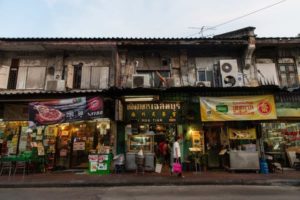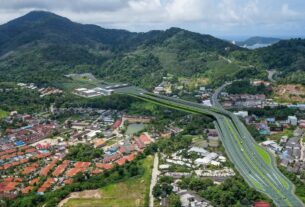
High-Rises are on the horizon for Bangkok’s Chinatown
10 percent to 20 percent of the old buildings in Chinatown have already disappeared in recent years
15 October 2019
On the northern edge of Bangkok’s Chinatown is a fenced-in, six-acre lot filled with vacant two-story shops where the only sound is the yowling of abandoned cats.
Once a thriving market that specialized in auto parts and musical instruments, the lot has been bought by a developer in preparation for something bigger and flashier — a vision of what some people fear could happen to the rest of one of the world’s oldest Chinatowns.
Like other Chinatowns, this one has evolved over time as successive waves of immigrants and their descendants have come and gone.
But now it is facing a new round of changes spurred by the opening of two subway stations that will connect it more easily to the rest of the city, and real estate developers have started moving in.
They have not disclosed plans for their developments, and much of the area they take over may stay vacant for some time, as the city has an oversupply of new condominiums, which experts believe may take a year or two to fill up.
Yet some 10 percent to 20 percent of the old buildings in Chinatown have already disappeared in recent years, according to Tiamsoon Sirisrisak, a lecturer on culture and heritage at Mahidol University.
These include an entire block of wedding dress shops that were destroyed to make way for one of the subway stops.
Thailand has undergone a boom recently in real estate, much of it fueled by Chinese nationals who spent a record 40 billion baht ($1.3 billion) on Thai properties last year, according to the Bank of Thailand, buying largely as a means to store wealth abroad.
They are drawn by the same relaxed ambience that brings tourists, along with more affordable prices than are found elsewhere in Asia, said Michael Cole, the founder and managing director of the independent real estate website Mingtiandi.
Most buyers in the Chinatown area, however, are rich Thai-Chinese rather than mainland Chinese, who prefer areas closer to the center of the city or near the river, said Annop Vongchumpit, vice president and head of business at The Agent Company, a property management firm.
High-end condominiums in Bangkok range from about $11,000 per square meter to $20,000 per square meter. One-bedroom condos in the Chidlom and Thonglor areas start at about $416,000, rising to $833,000 along the river and $1.2 million on Wireless Road, Mr. Annop said.
Although it may not appreciate sharply, Thai real estate does not tend to lose value, so it is viewed as a safe investment for people who want to park their money abroad, Mr. Cole said.
Thailand does have zoning laws that are designed to protect certain areas of land, experts say, but they are poorly enforced.
The future may bring a “new modern 21st century version of Chinatown which is driven by money,” said Michael Biedassek, a Thai-German who manages a tour agency, Bangkokvanguards, and leads walking tours through Chinatown’s narrow streets.
The changes would be in keeping with decades of development that have eliminated other traditional neighborhoods in Bangkok.
“They want to show that they are a first-world country, and you don’t do that by saving old buildings, but by having impressive high-rises and shopping malls and rich people everywhere,” Mr. Biedassek said.
Along with much of the old architecture, he said, Chinatown may lose some of the bustle and chaotic street life that make up its cultural fabric.
There are already signs of this, as younger generations move out and the small shops and homes they leave behind are converted into warehouses or left empty.
New, upscale coffee shops and guesthouses have begun to appear and are likely to flourish as the subways make Chinatown more accessible to tourists. Outside its narrow lanes, a major Chinese thoroughfare, Yaowarat, is already packed with visitors, who crowd its food stalls and restaurants at night.
These changes have led to a discussion about the meaning of heritage and of what elements of an urban landscape are worth preserving — whether simply the buildings and architecture or the vernacular culture, exemplified in Chinatown’s busy marketplaces.
The Talat Mai market, for example, pulses with the life of Chinatown, noisy and vibrant in the hours before dawn but not beautiful, a place where the carcasses of pigs are loaded onto carts, piles of plucked chickens lie on the ground, and laborers pull heavy carts, shouting their way through congested walkways.
With a new subway station opening nearby, there are plans for unspecified renovations in Talat Mai that could impose a new orderliness.
The vernacular culture includes separate small neighborhoods that have what amount to community bulletin boards displaying notices and Chinese calendars that note auspicious days for weddings, funerals and other events.
Many Chinese traditions are centered on the area’s temples, including one where a sick person can receive a divine medical prescription and have it filled at an adjoining herbal-medicine shop.
One neighborhood under direct threat from the subway stations is Charoen Chai, whose narrow lanes are dominated by a quintessentially Chinese trade in votive paper effigies, which are burned on special occasions as offerings to ancestors.
The paper offerings are “all handmade in the traditional way,” said Sirinee Urunanont, who manages a museum dedicated to the Charoen Chai neighborhood. “This is the heart of Chinese culture.”
The effigies are common throughout much of Asia. They are meant to bring earthly comforts to ancestors in the afterlife, whether cars, motorbikes, kitchen utensils or smartphones.
Thanyada Saraphan is a sort of real estate agent for the other world, selling paper villas and condominiums complete with deeds at $10 for a house and $16 for a mansion. All are destined to be ceremoniously burned.
She notes the irony of these carefully prepared deeds. Like other residents of Charoen Chai she has no deed to her own home and its lease has been systematically shortened from five years to two years to month-to-month rentals, raising fears of eviction.
“They have a tricky way of evicting people, just raising their rents step by step,” said Ms. Sirinee. “No one has told us what is going to happen, and we can’t find out what they are planning. All we have is rumors.”
The rumors are a tactic to weaken people’s resolve and induce them to leave, said Mr. Tiamsoon, the university lecturer.
One shopkeeper named Phumsith Purithongrat, known jokingly as “the richest man on the block,” sells stacks of paper money to be burned for spending in the hereafter. He plans to one day hand over his business to his son, but he worries about the changes to come.
“It’s like we are living in a village here,” he said. “New people will come in who don’t understand our life. The roots will be gone and we will be cut off from our ancestors.”
Chinese traders and immigrants have been coming to Thailand for centuries, and many at first lived clustered in an area along the Chao Phraya river. When King Rama I chose this site for his new palaces in the late 18th century, the community moved a short way to the south, clustering in the Sampheng area, which remains its core.
Mr. Phumsith’s mother, Pimploy, tells a family story that goes back more than a century. It begins with poor immigrants who found work making cloth shorts used by rickshaw drivers.
With the introduction of the electric tram car at the end of the 19th century, the rickshaws began to disappear, and the family adapted by opening a small grocery. But new air-conditioned department stores took away their customers, and the family moved on, like its neighbors, to selling votive papers.
“With the MRT coming in, we don’t know what will happen, Ms. Pimploy said, referring to the Metropolitan Rapid Transit system, “but I will ask them to let us stay here.”
Source: https://www.nytimes.com/2019/10/15/realestate/bangkok-chinatown-high-rises.html

